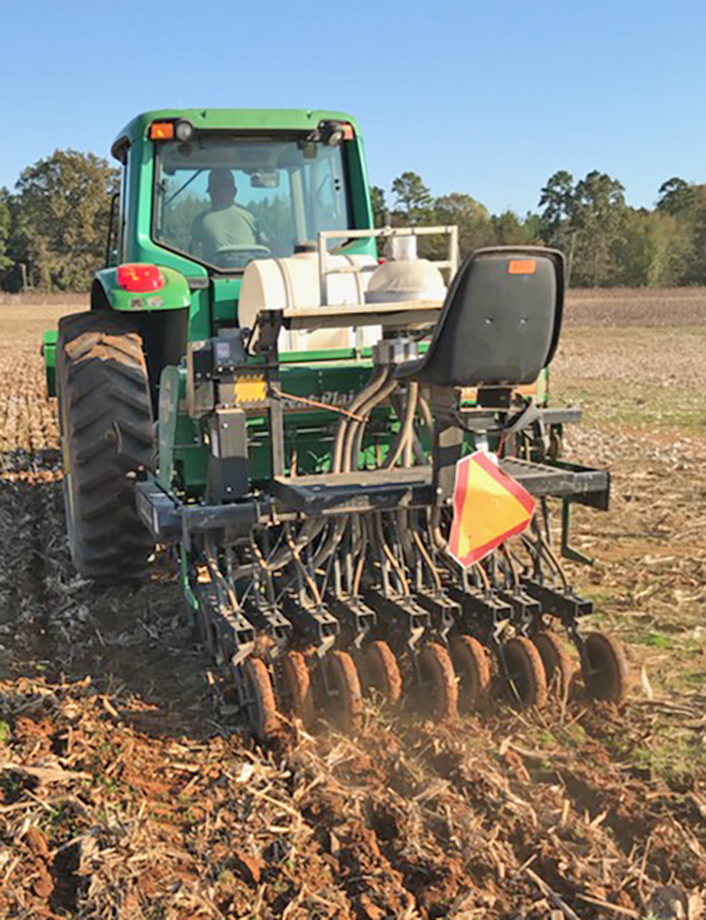Cover Crops: Establishment and Termination Guide
Cover crops are widely known for providing numerous long-term soil benefits. Some of the most popular benefits are reducing soil erosion and compaction, suppressing weeds, increasing organic matter, improving soil microbe activity, fixing nitrogen, and recycling nutrients. Some brassica species are known to lower nematode and disease populations.
Many plant species are viable options for cover crops, but each one has positive and negative characteristics that should be considered. Some species are more beneficial for erosion control or building organic matter (rye, wheat, oats, barley), whereas others excel at nitrogen accumulation (clovers, winter peas, vetch). Tillage radishes and small grains are good choices for reducing soil compaction, and mustards are good for suppressing insect pests.
Since one species cannot provide every benefit, determining top priorities for each field is critical for optimizing success. Some fields may require only one species to fulfill needs, while other fields may benefit more from planting multiple species. Planting multiple species can provide mutual benefits (Figure 1). For example, a vining legume performs better when it grows up a grass stalk, and the grass benefits from the legume’s nitrogen fixation. Planting more than three species can increase competition for water, light, and nutrients and make it difficult to achieve proper seeding depth for each species. Planting at improper depths will lead to less vigor and more competition for sunlight and nutrients, which reduces overall benefits.
Establishment
Plant establishment is the most critical aspect in any planting, whether it is for a cover or cash crop. Purchase only high-quality seeds to prevent issues later in the growing season. High-quality seeds should have a testing label attached that provides important information about the characteristics of the seed. Pure seed and germination percent are the most frequently considered aspects, but percent hard seed and percent inert material are important when determining pounds of seed per acre to be planted. Also, verify that the test date is recent because seeds lose a lot of quality in a year. Legumes are frequently treated with a fungicide and/or rhizobium inoculant. These treatments help achieve good stands, but they reduce weight of pure live seed (PLS) in a bag by up to 55 percent. If a bag of seeds is 55 percent fungicide or inoculant, the bag contains 45 percent or less actual seeds. To determine how much seed to plant to achieve 20 pounds PLS per acre from a lot of crimson clover seeds, read the label and then do some simple math.
Dixie Reseeding Crimson Clover – Coated
- Lot L73-17-CC3740AC
- Pure Seed: 46.75%
- Crop Seed: .00%
- Inert Matter: 53.25%
- Weed Seeds .00%
- Test Date: 8/2018
- (No Noxious Weeds)
- Net Weight: 50 LB
- Germination: 80%
- Hard Seed: 0%
- Total Germination and Hard Seed: 80%
- Origin: Oregon
**Inert contains 53.09% Coating Material**
The label shows pure seed is 46.25 percent and germination is 80 percent, so the correct conversion is calculated as follows:
Desired rate (20 lb PLS) ÷ 0.4675 pure seed = 42.78 lb
42.78 lb ÷ 0.80 germination = 53.48 lb
Plant 54 lb seed from this seed lot to achieve 20 lb PLS/acre.
If the seed lot has hard seed, it must be taken into account because, while hard seed has the capacity to germinate, it likely will not germinate and provide acceptable growth.
Poor establishment will reduce stand percentage, stand uniformity, and biomass and nitrogen accumulation. Weak, spotty stands allow weed escapes to take water and nutrients away from the cover crop. Take the time to decide what cover crop species will best address the needs of your field, when they should be seeded, and how they should be seeded. Failure to get a good stand wastes time and money.
Broadcast Seeding
Broadcasting is the easiest yet most problematic seeding method. Broadcasting is simply “throwing” seeds randomly onto the ground. In conventional tillage, lightly incorporating seeds with a harrow or pressing into the soil with a cultipacker (Figure 2) increases chances of success. In no-till fields, seeds are left as they fall on the surface. Both techniques are fast and easy, but many plants may die shortly after germination as the soil dries and roots cannot reach moisture. If using this method, you should increase the seeding rate by 25 to 50 percent to compensate for lost plants. Broadcasting is not recommended when planting multiple species because they require different seeding depths.
Drilling
Using a grain or seed drill is the most accurate method for seeding cover crops and is especially valuable when multiple species will be planted. Many drills have two seed hoppers with separate furrow openers and seed-covering devices. Drills plant seeds in a continuous, uniform rate at a precise depth and spacing (Figure 3). Before planting, determine the correct seeding depth for all species to be planted. Many grasses have optimum seeding depths between 0.5 and 2.0 inches. Legume seeding depths range from 0.2 to 3.0 inches, and brassica seeding depths range from 0.1 to 0.5 inches. Planting seeds too deeply may prevent plants from emerging, whereas shallow planting may lead to reduced vigor, freeze injury, and grazing damage. Drills are expensive, but numerous agencies maintain units that are available for rent at reasonable prices. Contact your local MSU Extension office or NRCS office to locate potential rental equipment.

Overseeding
Overseeding a cover crop into a growing row crop is slowly gaining attention. Cover crop seeds are planted before the cash crop is harvested to allow more growth before winter arrives. This is most often done just before cotton or soybean defoliation. The falling leaves create a mulch-type environment for the cover crop seedlings. This practice is not common, but it may lengthen the growing season of the cover crop enough to increase its benefits.
Termination Methods and Timing
Most cover crops are terminated via herbicide applications of glyphosate alone or in combination with dicamba or 2,4-D. Herbicides such as Liberty, Sharpen, or Goal are occasionally used, but they are more expensive and can increase planting restrictions. Herbicides are cost-effective but must be applied at appropriate rates, with sufficient coverage, and at the correct growth stage to achieve adequate termination.
Roller-crimpers are rolling drums with chevron blades designed to roll over the cover crop and crimp the stems to terminate the plant (Figure 4). They work best with small grains and legumes that have stems at least 16 inches tall. Shorter plants receiving only one crimp may survive. The roller-crimper needs moist soil conditions to allow blades to push into the soil for best performance. Roller-crimpers are slow to operate, and soil topography is critical for good control, but they can fit well in organic production systems.
The timing of termination depends on cover crop used and cash crop to be planted. Terminate early if planting corn, if soil moisture is short, or if insects are a concern. “Green bridge” is when host plants (cover crop or weeds) allow insects to increase populations and then begin feeding immediately on the cash crop. Prevent seedling damage in the cash crop by terminating early or applying insecticide at planting. Terminate later if planting cotton, soybeans, or sweet potatoes; if soil moisture is high; or if legumes need more time to fix nitrogen. Producers new to using cover crops should consider terminating early to keep their options open if failures occur. Producers who are comfortable using cover crops can delay termination to allow the cover crop additional time to provide more benefits such as building organic matter, supplying nitrogen, or conserving moisture.
Producers should begin with one or two species and gain experience and comfort with cover crops. Once comfortable, slowly increase how many species are used, and modify the species to achieve your desired goals.

This material is based upon work that is supported by the national institute of food and agriculture, U.S. Department of Agriculture, under award number rd309-137/s001396 through the Southern Sustainable Agriculture Research and Education program under subaward number 20163864025382.
Publication 3417 (02-20)
By Bill Burdine, PhD, Extension Specialist, Agronomic Crops.
The Mississippi State University Extension Service is working to ensure all web content is accessible to all users. If you need assistance accessing any of our content, please email the webteam or call 662-325-2262.


